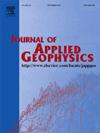Application of 3-D inversion of AMT data in exploration of concealed nonmetallic deposits: A Case Study on the Huashitou Mountain fluorite deposit in Beishan metallogenic belt, China
IF 2.2
3区 地球科学
Q2 GEOSCIENCES, MULTIDISCIPLINARY
引用次数: 0
Abstract
This study utilized audio-frequency magnetotelluric (AMT) data collected from a concealed fluorite deposit on Huashitou Mountain in the Beishan metallogenic belt to obtain a 3-D resistivity model beneath the deposit. The fluorite ore-forming mechanism was determined and is discussed in combination with previous high-resolution magnetic and induced-polarization imaging results. Our study revealed a large high-resistivity body, R2 (> 1000 Ω·m), corresponding to the low induced-polarization and low-magnetic region that extends from 40 to > 80 m in depth. We suggest that this corresponds to the Indosinian intrusive granite, and potentially serves as a fluorite mineralization rock mass. A highly conductive zone, C3 (< 3 Ω·m), extending from approximately 20 to 300 m, or even deeper, was interpreted as a deep fault/fracture zone functioning as a fluid pathway for fluorite mineralization. Two smaller conductive zones, C1 and C2 (< 20 Ω·m), appear above the high-resistivity granite intrusion. These zones correspond well with high induced-polarization anomalies (> 2.5 % threshold), relatively high-△T anomalies (−50 nT), and hematite alteration areas shown on the geological cross-sections. These zones were interpreted as two near-surface secondary fault structures. The aforementioned fault structures are believed to have formed before the main mineralization period of the fluorite deposit and were subsequently reactivated during intense tectonic-magmatic activity in the Late Hercynian. Hot fluids enriched with volatile components (e.g., F and CO2) were transported along the deep fault, represented by C3, from the lower crust to the near-surface secondary fault zones (represented by C1 and C2). These fluids interacted with the calcic plagioclase in alkaline granite magma to form fluorite (mainly composing CaF2) through calcium extraction. Further, the process led to hydrothermal alteration, resulting in associated iron-oxide mineralization or silicification alteration zones, as well as alterations related to a sedimentary layer such as kaolinization and chloritization. These zones exhibit high conductivity because of their significant porosity and the presence of fluids or metal sulfides.
AMT数据三维反演在隐伏非金属矿床勘查中的应用——以北山成矿带华石头山萤石矿床为例
利用北山成矿带华石头山隐伏萤石矿床的音频大地电磁(AMT)资料,建立了矿床地下三维电阻率模型。结合前人的高分辨率磁感应偏振成像结果,确定了萤石成矿机理,并对其进行了讨论。我们的研究发现了一个大的高电阻率体,R2 (>;1000 Ω·m),对应从40 ~ >的低感应极化低磁区;80米深。我们认为这对应于印支期侵入花岗岩,可能是萤石成矿岩体。高导电区,C3 (<;3 Ω·m),从大约20到300米,甚至更深,被解释为一个深断裂/破裂带,作为萤石成矿的流体通道。两个较小的导电区,C1和C2 (<;20 Ω·m),出现在高电阻率花岗岩侵入体上方。这些区域与高诱导极化异常(>;2.5%阈值)、较高的△T异常(- 50 nT)和地质剖面上的赤铁矿蚀变区。这些带被解释为两个近地表次级断裂构造。上述断裂构造形成于萤石矿床主成矿期之前,并在晚海西期强烈的构造岩浆活动中被重新激活。富含挥发性组分(如F和CO2)的热流体沿着以C3为代表的深断裂从下地壳输送到以C1和C2为代表的近地表次级断裂带。这些流体与碱性花岗岩岩浆中的钙斜长石相互作用,通过钙萃取形成萤石(主要成分为CaF2)。此外,这一过程导致热液蚀变,导致相关的氧化铁矿化或硅化蚀变带,以及与沉积层相关的蚀变,如高岭土化和绿泥化。这些层具有高导电性,因为它们具有显著的孔隙度和流体或金属硫化物的存在。
本文章由计算机程序翻译,如有差异,请以英文原文为准。
求助全文
约1分钟内获得全文
求助全文
来源期刊

Journal of Applied Geophysics
地学-地球科学综合
CiteScore
3.60
自引率
10.00%
发文量
274
审稿时长
4 months
期刊介绍:
The Journal of Applied Geophysics with its key objective of responding to pertinent and timely needs, places particular emphasis on methodological developments and innovative applications of geophysical techniques for addressing environmental, engineering, and hydrological problems. Related topical research in exploration geophysics and in soil and rock physics is also covered by the Journal of Applied Geophysics.
 求助内容:
求助内容: 应助结果提醒方式:
应助结果提醒方式:


